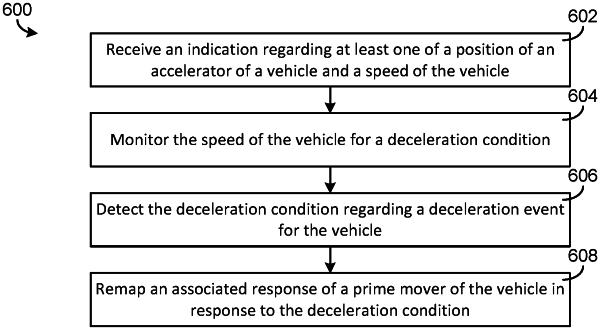| CPC B60W 50/00 (2013.01) [B60W 2050/0088 (2013.01)] | 15 Claims |

|
1. An apparatus, comprising:
a position circuit structured to monitor a position of an accelerator of a vehicle, the position corresponding with an associated response of a prime mover of the vehicle, the associated response including at least one of a torque output and a power output of the prime mover;
a speed circuit structured to monitor a speed of the vehicle;
a response management circuit communicably coupled to the position circuit and the speed circuit, the response management circuit structured to:
receive an indication regarding the position of the accelerator and the speed of the vehicle;
determine that the indication satisfies a remapping condition, the remapping condition including at least one of a creep condition, an obstacle condition, a deceleration condition, and a reverse condition; and
dynamically remap the associated response of the prime mover of the vehicle based on the position of the accelerator in response to the indication satisfying the remapping condition;
an obstacle detection circuit structured to detect the obstacle condition regarding a respective wheel of the vehicle encountering an obstacle (i) in response to determining that the respective wheel is elevating or extending as a result of the respective wheel encountering the obstacle and (ii) while the speed of the vehicle is less than a predefined obstacle threshold speed level such that engagement of the respective wheel with the obstacle slows or stops the vehicle from moving, wherein the response management circuit is structured to remap the associated response of the prime mover in response to (i) the detection of the obstacle condition and (ii) the speed of the vehicle being less than the predefined obstacle threshold speed level such that the associated response of the prime mover increases for a respective position of the accelerator and, therefore, the respective wheel is capable of traversing the obstacle without requiring an operator increase in the position of the accelerator; and
a deceleration circuit structured to detect the deceleration condition regarding a deceleration event for the vehicle, wherein the prime mover is configured to provide a negative torque response and a positive torque response with a zero torque operating condition between the negative torque response and the positive torque response, wherein the response management circuit is structured to remap the associated response of the prime mover of the vehicle from following a normal response curve to following a deceleration response curve in response to the deceleration condition, and wherein (a) a first slope of the negative torque response for the deceleration response curve is greater than a second slope of the negative torque response for the normal response curve and (b) a first range of the zero torque operating condition for the deceleration response curve is smaller than a second range of the zero torque operating condition for the normal response curve, thereby reducing an overall range of the accelerator that is associated with the negative torque response and the zero torque operating condition such that, upon a subsequent acceleration following the deceleration event in response to the accelerator being engaged by the operator and in accordance with the positive torque response of the prime mover, an output of the prime mover to accelerate the vehicle activates at a relatively lesser amount of depression of the accelerator from a non-depressed state of the accelerator than prior to the deceleration event.
|